
An effects unit or effectspedal is an electronic device that alters the sound of a musical instrument or other audio source.

An electric guitar is a guitar that uses one or more pickups to convert the vibration of its strings into electrical signals. The vibration occurs when a guitar player strums, plucks, fingerpicks, slaps or taps the strings. The pickup generally uses electromagnetic induction to create this signal, which being relatively weak is fed into a guitar amplifier before being sent to the speaker(s), which converts it into audible sound.
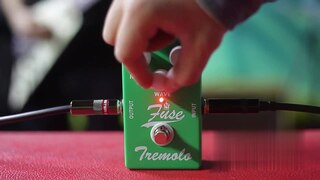
In music, tremolo, or tremolando, is a trembling effect. There are two types of tremolo.

An electronic keyboard, portable keyboard, or digital keyboard is an electronic musical instrument, an electronic or digital derivative of keyboard instruments. Broadly speaking, the term electronic keyboard or just a keyboard can refer to any type of digital or electronic keyboard instrument. These include synthesizers, digital pianos, stage pianos, electronic organs and digital audio workstations. However, an electronic keyboard is more specifically a synthesizer with a built-in low-wattage power amplifier and small loudspeakers.
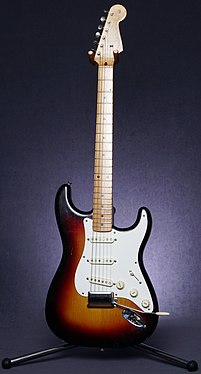
The Fender Stratocaster is a model of electric guitar designed from 1952 into 1954 by Leo Fender, Bill Carson, George Fullerton, and completed by Freddie Tavares. The Fender Musical Instruments Corporation has continuously manufactured the Stratocaster from 1954 to the present. It is a double-cutaway guitar, with an extended top "horn" shape for balance like the Precision Bass guitar. Along with the Gibson Les Paul and Fender Telecaster, it is one of the most-often emulated electric guitar shapes. "Stratocaster" and "Strat" are trademark terms belonging to Fender. Guitars that duplicate the Stratocaster by other manufacturers are usually called S-Type or ST-type guitars.

The Bigsby vibrato tailpiece is a type of mechanical vibrato device for electric guitar designed by Paul Bigsby and produced by the Bigsby Electric Guitar Company. The device allows musicians to bend the pitch of notes or entire chords with their pick hand for various effects.
A vibrato system on a guitar is a mechanical device used to temporarily change the pitch of the strings. Instruments without a vibrato have other bridge and tailpiece systems. They add vibrato to the sound by changing the tension of the strings, typically at the bridge or tailpiece of an electric guitar using a controlling lever, which is alternately referred to as a whammy bar, vibrato bar, or incorrectly as a tremolo arm. The lever enables the player to quickly and temporarily vary the tension and sometimes length of the strings, changing the pitch to create a vibrato, portamento, or pitch bend effect.
The Fender Bass VI, originally known as the Fender VI, is a six-string electric bass guitar made by Fender.
Paul Adelburt Bigsby (1899–1968) was an American inventor, designer, and pioneer of the solid body electric guitar. Bigsby is best known for having been the designer of the Bigsby vibrato tailpiece and proprietor of Bigsby Electric Guitars. He built an early steel guitar for Southern California steel guitarist Earl "Joaquin" Murphy of Spade Cooley's band, as well as Jack Rivers, then built a solid body electric guitar conceptualized by Merle Travis to have the same level of sustain as a steel guitar by anchoring the strings in the body instead of on a tailpiece. This instrument, which Bigsby completed in 1948, likely had an influence on the solid body Telecaster later produced by Leo Fender, as it had all six tuners in a row. Its headstock shape was later made famous by Fender's solid body Stratocaster model. Bigsby also made a doubleneck model for Nashville guitarist Grady Martin and an amplified mandolin for Texas Playboy Tiny Moore. Bigsby also built a pedal steel guitar for Speedy West that West used on many of Tennessee Ernie Ford's early recordings as well as records by Travis, Red Ingle, Jean Shepard, Johnny Horton, Ferlin Husky and Merrill Moore.
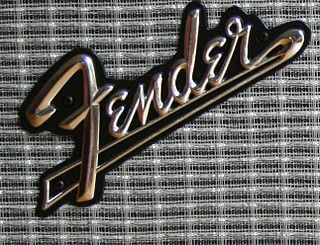
Leo Fender began building guitar amplifiers before he started manufacturing electric guitars. The first of these were the K&F models, produced between 1945 and 1946. The early K&F and Fender amplifiers relied upon vacuum tube circuitry, with the company adding solid-state models in the late 1960s.
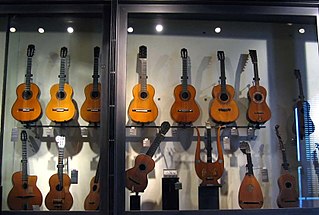
The following outline is provided as an overview of and topical guide to guitars:

The Fender Twin and Twin Reverb are guitar amplifiers made by Fender Musical Instruments Corporation. The Twin was introduced in 1952, two years before Fender began selling Stratocaster electric guitars. The amps are known for their characteristically clean tone.
The Fender Tremolux was a guitar amplifier made by Fender. It was introduced in the summer of 1955 with a rated power output of 15 watts, cathode bias, two 6V6 output tubes, and a 5V4 tube rectifier. The Tremolux was the first Fender amp with a built in effect, tremolo.

The Stetsbar Tremolo system is a vibrato bridge system for the electric guitar. Eric Stets developed the device in the late ‘80s, and patented it in 1995. He originally designed the device to provide a stable vibrato system that could retrofit to “stop-tail” guitars such as the Gibson Les Paul with no permanent modifications to the instrument.
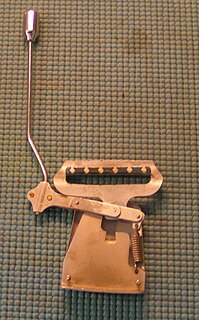
Doc Kauffman was a lap steel guitar, electric guitar engineer, inventor & pioneer of the world's first patented guitar vibrola. The patent for "Apparatus for producing tremolo effects" was applied for in 1928 and officially granted to Doc Kauffman on January 5, 1932.

A bridge is a device that supports the strings on a stringed musical instrument and transmits the vibration of those strings to another structural component of the instrument—typically a soundboard, such as the top of a guitar or violin—which transfers the sound to the surrounding air. Depending on the instrument, the bridge may be made of carved wood, metal or other materials. The bridge supports the strings and holds them over the body of the instrument under tension.
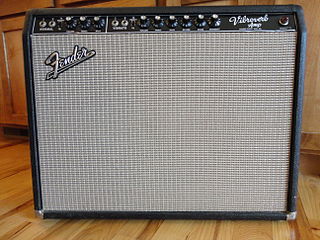
The Fender Vibroverb was a 40-watt combo guitar amplifier originally manufactured in 1963 and 1964. It was the first Fender amplifier to incorporate on-board reverb which became a standard feature on many high-end Fender tube amps during the 1960s and 1970s.

Magnatone was a brand of electric guitars and amplifiers produced between 1937 and the mid-1970s. The company was based in California. The brand name was revived in the 2010s by Ted Kornblum.
Tremolo, in electronics, is the variation in amplitude of sound achieved through electronic means, sometimes mistakenly called vibrato, and producing a sound somewhat reminiscent of flanging, referred to as an "underwater effect". A variety of means are available to achieve the effect. For further information about the use of tremolo in music, including notation, see Tremolo.

Bigsby Vibratos is a brand of vibrato systems for guitars that operated as an independent company by Paul Bigsby manufacturing electric guitars until 1966 when it was purchased by ex-Gibson executive Ted McCarty. In 1999, the brand was acquired by Gretsch from McCarty, which owned it until 2019, when Bigsby was sold to Fender Musical Instruments Corporation.
















